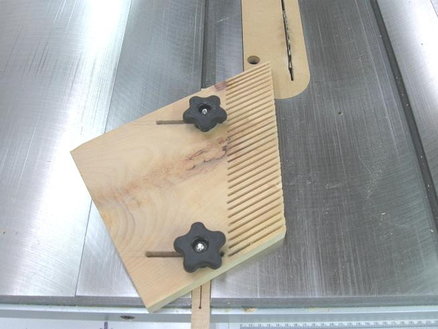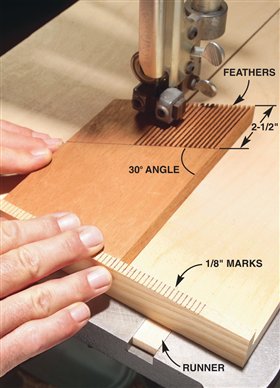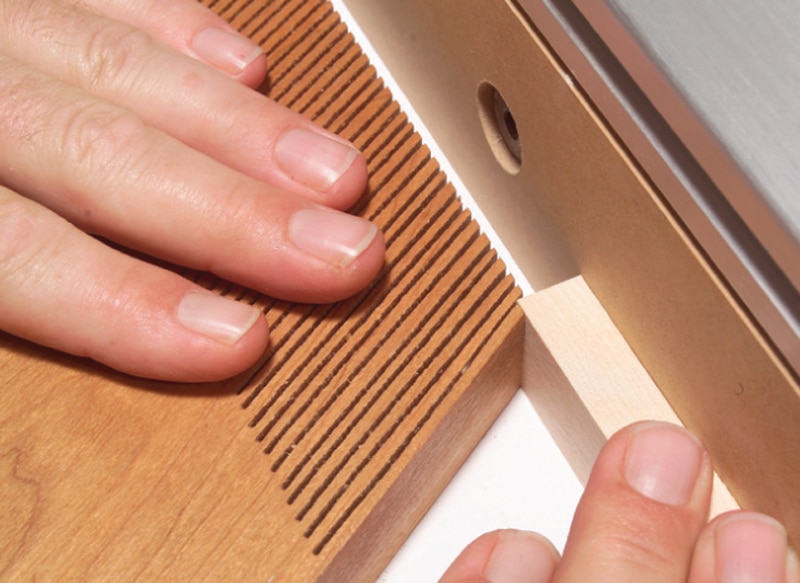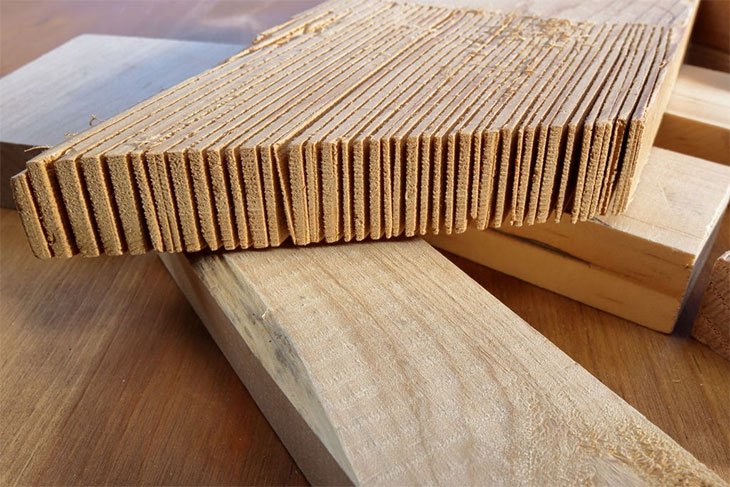Before we discuss how to make a featherboard. Let’s start off describing what a featherboard is. It is a 3/4x 3 x11 inch piece of wood that is cut from a piece of larger wood that has a straight grain.
The featherboard is cut cross ways at a 30-degree or 45-degree angle with many fingers or "feathers cut 1/8 of an inch" apart across the grain of the featherboard. In this way, the fingers will bend in the direction that the piece of wood will travel.
Now, that we know what the featherboard we can see why they are used.
More...
What is featherboard?

Via: lumberjocks.com
Basically, the featherboard is a designed piece of wood that is put on the fence of the saw to hold down the piece that is to be cut or machined. The featherboard holds the stock in place by applying even pressure throughout the cutting process.
Another purpose for the featherboard is to keep the stock from “kicking back” which could be hazardous.
The featherboard is a better option to use than having a human operator run the piece through the saw. The featherboard can go places human fingers shouldn’t on the saw.
Now, let’s get to the heart of the matter of how to make a featherboard.
Before you start any ripping make sure you loosen the gate so you can mark the board. Then set the gate against the board and tighten it up.
How to make a featherboard?
1. Making the form of the featherboard for a table saw or router table
First, choose a good piece of wood that has no defects, cuts, knots, knot holes or any rough spots on the surface of the wood.
You want to make sure you have a flat, level, and clean piece of wood that will work properly when you make the final product. So now you have chosen a good piece of wood to work with.
Take the piece of 3/4“x5”x18” wood and measure/mark a 30-degree line using an aluminum roof square. Flip the board over and repeat this step. Now, cut the 30-degree angle into one end of the board. Use a table saw to cut the ends.
Turn it around and repeat the process on the other end. Be careful to cut the angles so they slant in the same direction. The next step is making the fingers in the wooden featherboard.
2. Cutting the fingers in the featherboard
Now, you will want to draw lines precisely two inches down from each cut end. These lines will be the stopping points to end your cuts. You will want to set your fence panel to 1/4 “making sure your cuts for the fingers on this side of the board 1/4” wide. Next, you will make the first cut on the line drawn earlier.
Ideally, you will want to cut the fingers on the short end of the wood. In this way, any undercut will be on the bottom of the board. (Make sure the blade on your saw is as high as it will go. This will minimize the undercut on the bottom of the board.)

Via: popularwoodworking.com
Please make sure you hold onto your stock until you reach the end of the line to finish the cut. Shut off the saw.
Be sure after every cut you shut your saw off for safety reasons. You will want all your fingers to be the same length. So go ahead and add the width of the cut left by the blade to the first finger’s width of 1/4”.
Measure the (using digital calipers is recommended) kerf (the cut left by the blade) and it should measure 1/8”. This means that you add this to the 1/4” width of the first finger giving you a 3/8” total measurement. Now adjust your fence panel 3/8” before making the second cut.
From this point on you will need to adjust the fence panel by the 3/8” to compensate for the 1/8” cut made by the blade. Then cut all the rest of the fingers into the board in this same fashion. Follow this pattern until you reach the end of the board.
Why would you measure the kerf instead of the blade? Let’s find out.

Via: popularwoodworking.com
You want to measure the kerf instead of the blade because the blade is thinner than the actual cut it leaves in the wood.
The blade is designed this way so it will not bind the wood causing friction. If friction was formed from the blade on the wood; it would cause all kinds of potential hardships. There is another method to get the right spacing on the cuts.
This is done by ripping a gauge stick to the required 3/8” width. Make the first cut and turn the saw off. Remove the fence panel and put the gauge stick right against the board. Move the fence panel back. Lock the fence panel into position.
Take out the board and the stick and slide the board against the fence panel. Cut your finger to the desired width. Cut the rest of the fingers on the board the same way. We can compensate if there is a shortage of material to cut at end of the board.
You have reached the end of the board after cutting your fingers. It looks like there won’t be enough board width to cut the last two fingers. So eyeball the middle of the space and cut the last two fingers the best you can. If there is only a sliver of board left just cut one full finger to width. We are ready to move to the other side.
On this side, you will need to change the width of each finger cut. Instead of making the fingers 1/4” wide you will make them 3/16” wide. So adjust the fence panel to 5/16”. This will compensate for the 3/16” plus 1/8” for the kerf.The next step is making the mounting slots.
Read more —
3. Building the mounting slots
Start off by drawing a line one inch from each stop line and each side of the board. Use a router with 1/4” straight bit. Cut two lines lengthwise in the board between the one inch lines you just marked.
Don’t have a router?
Then drill a 1/4” hole in each corner of the inside lines you marked. Finish the cut with a jigsaw or keyhole saw.
Now we will attach the featherboard jig to the saw. First the runner needs to be built.
4. Constructing the runner for the miter slot

Let’s say the miter slot on your table saw is 3/4” by just over 3/8” deep. You will need a board about 18” long to start the process with. Later on, you will trim it down to 12”. Put the featherboard with the fingers flat right to the saw blade. You will center the runner.
Draw lines in the center of each slot; by marking the runner. Drill two 1/4” holes in the center of the lines. The tapered head machine screws will fit right into these holes. Make sure these holes are countersunk so the heads of the screws lie even with the runners. Now, you can move to the measuring step.
Use a square and measure 2”from the end of the runner to any dawn line you choose. Measure 2“ from that line you just drew and then draw another. Copy this process for the other side. Drill a 1/4 “hole in each of the lines. Countersink the two center holes. Get your jigsaw.
Cut, with your jigsaw, using a narrow blade, cut from one end of the hole through the middle of the runner to the other hole. Cut excess wood from the outer lines to finish the runner. It’s time to put the featherboard together.
5. Assemble the featherboard
Place the taper head machine screws through the countersunk holes in the runner. Attach this piece into the miter slot.
Attach the featherboard to the runner with the screws through the slots on the board. Put the washers over the screws and tighten the knobs. The job is complete.
6. Miscellaneous
How to build a featherboard for a router table you just need to modify the above building process. You will need to purchase the best router table you can find. If you want to go ahead and buy a featherboard. A good choice would be to purchase a magnetic featherboard.
In the end result building, your own featherboard will be the best option.
Conclusion
This article was written to help you build your own featherboard. Building a featherboard is simple and straight forward. Hopefully, you have received enough instruction to go ahead and build your own featherboard from scratch.
Did you enjoy this article on “How to build a featherboard?”
Please share this tutorial with your friends and leave a comment. Get out there and start ripping some wood and build yourself a featherboard that will last for years!
